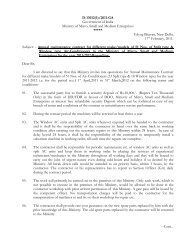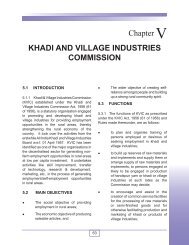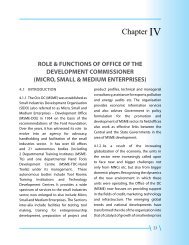Evaluation Study MSE Cluster Development - Ministry of Micro ...
Evaluation Study MSE Cluster Development - Ministry of Micro ...
Evaluation Study MSE Cluster Development - Ministry of Micro ...
Create successful ePaper yourself
Turn your PDF publications into a flip-book with our unique Google optimized e-Paper software.
Chapter No: 6 – Hard Interventions in Sampled <strong>Cluster</strong>s6.3 The Rationale and Objectives <strong>of</strong> Hard InterventionsThere are several benefits that have accrued to SMEs who have collectively formed aconsortium in the form <strong>of</strong> a SPV, which is a legally constituted entity. These benefitshave been exploited in one or more ways and have helped in the improvement <strong>of</strong>margins, and thus their individual incomes as well as competitiveness, we feel it isessential to briefly describe these collective initiatives and highlight some <strong>of</strong> the casesacross clusters in India.These hard interventions have been as follow:SPVs to exploit Supplier/Market Access- The SPVs in this case directly accesssuppliers and customers without individually having to interact with their clients throughdistributors and other intermediaries. The margins that they surrender tointermediaries, who are <strong>of</strong>ten large, and affecting their own margins are thus effectivelycontrolled and internalized. The foundry cluster units in Hyderabad have directlyapproached the Steel Mills as against their suppliers who were basically steel distributorsand traders. The Wet Grinder <strong>Cluster</strong> in Coimbatore has been able to procure copperwire for their individual cluster units directly from manufacturers rather than dependingon local traders. The cases <strong>of</strong> many small coir units in Alleppey have similarly organizedthemselves to avoid middlemen and ‘coir depots’ to collectively access finance andmarkets. These are all real instances <strong>of</strong> collectively organizing in the form <strong>of</strong> a legalentity and accessing markets directly to improve individual incomes and margins.Individual cluster units can collectively take up harnessing Economies <strong>of</strong> Scale- commonmanufacturing processes on a large scale and <strong>of</strong> uniform quality and standards.Common components procured from outside the cluster can be manufactured in acommon facility. The cost <strong>of</strong> manufacture <strong>of</strong> these individually by the cluster unitsthough possible would be prohibitively expensive. A common process can also becollectively organized and the necessary investments (usually large) mobilized toeffectively exploit the economies <strong>of</strong> scales. The Wet Grinder <strong>Cluster</strong> in Coimbatore hasplanned a common facility to produce certain common components that were beingoutsourced from firms outside the cluster, this would not only reduce costs but also helpin controlling quality and standards. The export clusters producing home furnishings andtextiles in Kannur, Kerala, and Tirupur, Tamil Nadu respectively, have established theirown spinning mills to reduce units costs. Yet another example is <strong>of</strong> the Rubber <strong>Cluster</strong> inChenganacherry which has set up a mixing mill to reap the economies <strong>of</strong> scale, andimprove the quality and standards <strong>of</strong> the products manufactured and exported by theindividual units in the cluster.Improving Bargaining Power- Common bulk procurement <strong>of</strong> raw materials is yetanother initiative that can benefit individual units considerably and improve the collectivebargaining power as compared to the low bargaining strength that small and micro unitswould have. The Tery Towel <strong>Cluster</strong> in Sholapur, Maharashtra, has directly negotiatedwith spinning mills and traders for bulk purchases and common procurement <strong>of</strong> yarn.Harnessing <strong>of</strong> common energy options and use <strong>of</strong> by products and waste. There is anincreasing need for new and renewable energy sources that help in the progressive use<strong>of</strong> cleaner fuels and effectively supplement the energy needs <strong>of</strong> small and microenterprises. Common initiatives for harnessing wind energy, biogas, and even micro106
















